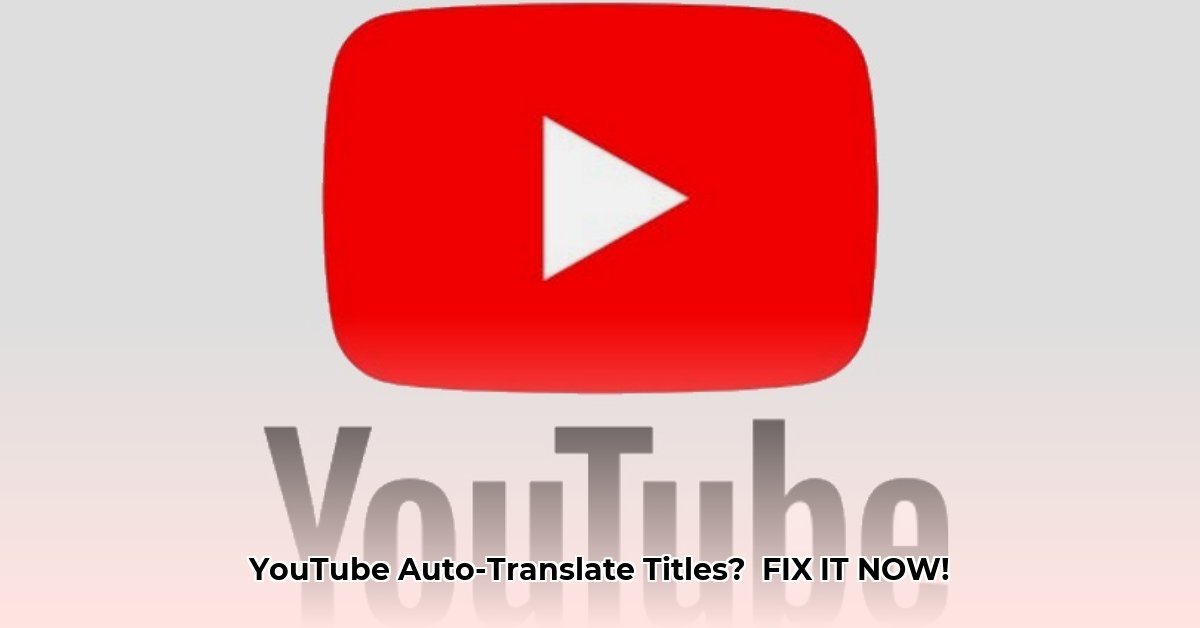
YouTube Translates Video Titles: Stop the Auto-Translate Madness!
Hey there, mate! So, YouTube's auto-translating your video titles, eh? That's a right pain! Don't worry, you're not alone. Lots of YouTubers are battling this "helpful" feature that's more hassle than help. Let’s sort this out, step-by-step.
Why's YouTube doing this? It's trying to make your videos reach a global audience. Sounds good, ja? But the reality is, these auto-translations are often, well, a bit kak. They're inaccurate, confusing, and can even hurt your views. It's like someone's messing with your subtitles without asking!
Fixing the YouTube Auto-Translate Title Problem: A Simple Guide
There's no single magic bullet. It's a bit of trial and error – tweaking settings in YouTube and your Google account. Let's tackle the most likely culprits.
1. Check Your Google Account Language Settings:
First up, head to your Google account settings. Make sure your preferred language is spot-on. This is often the root of the problem. If your Google language is wrong, it affects everything Google-related, including YouTube. Think of it like building a house – if the foundation's dodgy, the whole thing's off-kilter.
2. YouTube's Language Preferences: Another Check:
Now, jump into your YouTube settings. Verify your language setting matches your Google account. Sometimes these get out of sync, causing this mess. It's like two chefs using different recipes – you can't get a good dish!
3. Location, Location, Location:
Your location matters! YouTube uses it to determine the language. Check your YouTube location settings (and your device's, just in case). If YouTube thinks you're in another country, it'll translate everything into a language you don't understand. Makes sense, right?
4. Is a VPN the Culprit?:
Using a Virtual Private Network (VPN) (a service that masks your IP address and location)? It might be interfering with YouTube's language detection. Try switching it off temporarily to see if that fixes the problem. A VPN masks your actual location, leading to language confusion.
5. Clear Your Browser Cache: A Quick Clean-Up:
A clogged browser cache can cause all sorts of weirdness. Clearing it is a quick and easy fix to try – often works wonders for these kinds of glitches. Think of it as decluttering your computer – a bit of spring cleaning never hurts!
6. Mobile App Shenanigans:
Using the YouTube mobile app? The problem might be with your phone or tablet's language settings. Adjusting your device's language might need some extra effort, but could solve this.
Troubleshooting: When Things Don't Go to Plan
Translations Still a Mess: If the problem persists, report it directly to YouTube. The more detail you give, the better they can understand and fix the issue. They need your feedback to improve their system!
Translations Still Wrong?: Even after all this, YouTube's translations might be a bit dodgy. Their system is constantly improving – they're not perfect yet. You might need to manually add translations to your videos for accuracy. This takes more effort, but ensures it’s done right.
Handy Cheat Sheet: At a Glance
| Setting | Impact on Auto-Translated Titles | Potential Issues | Solutions |
|---|---|---|---|
| Google Account Language Settings | Massive Impact | Affects all Google services | Double-check and correct your Google language |
| YouTube Language Preferences | Massive Impact | Inconsistent settings between Google and YouTube | Ensure consistent settings across all platforms |
| Location Settings | Moderate Impact | Incorrect geolocation | Verify and correct location settings |
| VPN | Significant Impact | Interferes with language detection | Temporarily disable your VPN |
| Browser Cache | Minor Impact | Caching issues causing unexpected behaviour | Clear your browser cache |
| Mobile Device Language Settings | Significant Impact | Inconsistent language across apps | Change your device's language settings |
Remember, YouTube's auto-translation is automated, but you're in control of your settings. Don't give up! Keep adjusting settings, and you'll get those accurate video titles back!
How to Completely Disable YouTube Auto-Translate on Mobile (A South African Guide)
YouTube's auto-translate, while helpful for some, can be kwaai frustrating. Seeing video titles in a language you don't understand is annoying! This guide shows you how to completely disable YouTube auto-translate on your phone.
Understanding the Problem
Why does YouTube translate titles? Accessibility. YouTube wants global reach. But it often backfires. The problem lies in conflicting settings across your Google account, the YouTube app, and your phone's language preferences. It's like building a flat-pack cupboard with instructions in isiZulu and Afrikaans – chaos!
The Fix: A Step-by-Step Approach
Here’s how you regain control:
Check Your Google Account Language: Go to your Google Account settings (usually via your profile picture). Make sure your preferred language matches what you want on YouTube. A mismatch leads to translation mayhem.
Adjust Your Phone's Language Settings: Check your phone's language settings. Does it match your Google language? Inconsistencies affect YouTube translations.
YouTube App Settings (Limited Control): The YouTube app itself offers limited direct control. The key is aligning Google Account and device language settings.
Troubleshooting Tips
- Clear Your Cache and Cookies: Your phone's browser might be storing old translation data. Clearing it helps.
- Restart Your Phone: A simple restart often fixes minor software glitches.
- Update Your YouTube App: An outdated app might have bugs affecting translations. Check for updates.
Key Takeaways:
- Many settings influence YouTube's auto-translation.
- Fixing the problem involves adjusting Google account, phone, and app settings.
- Clearing cache and restarting your phone can solve minor issues.
- The YouTube app offers limited direct control over auto-translate. Aligning your Google Account and device language settings is crucial.